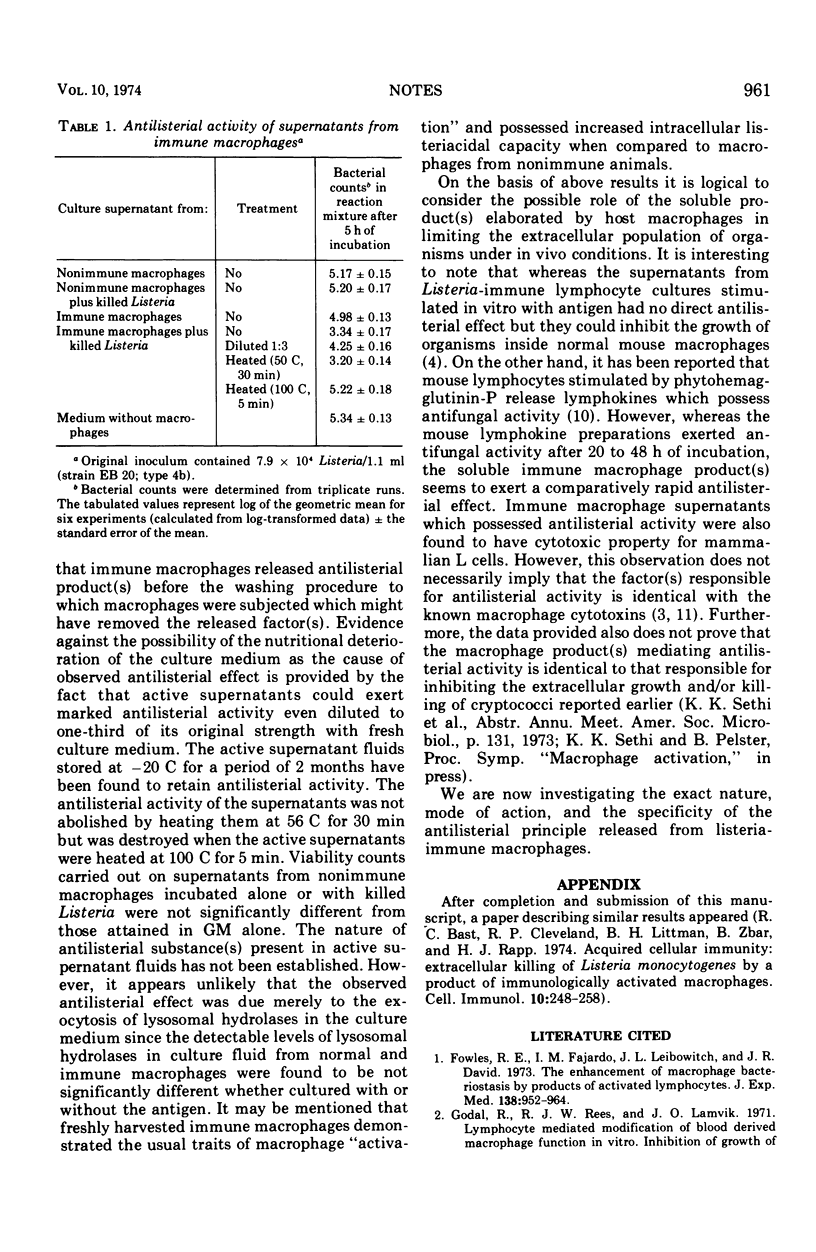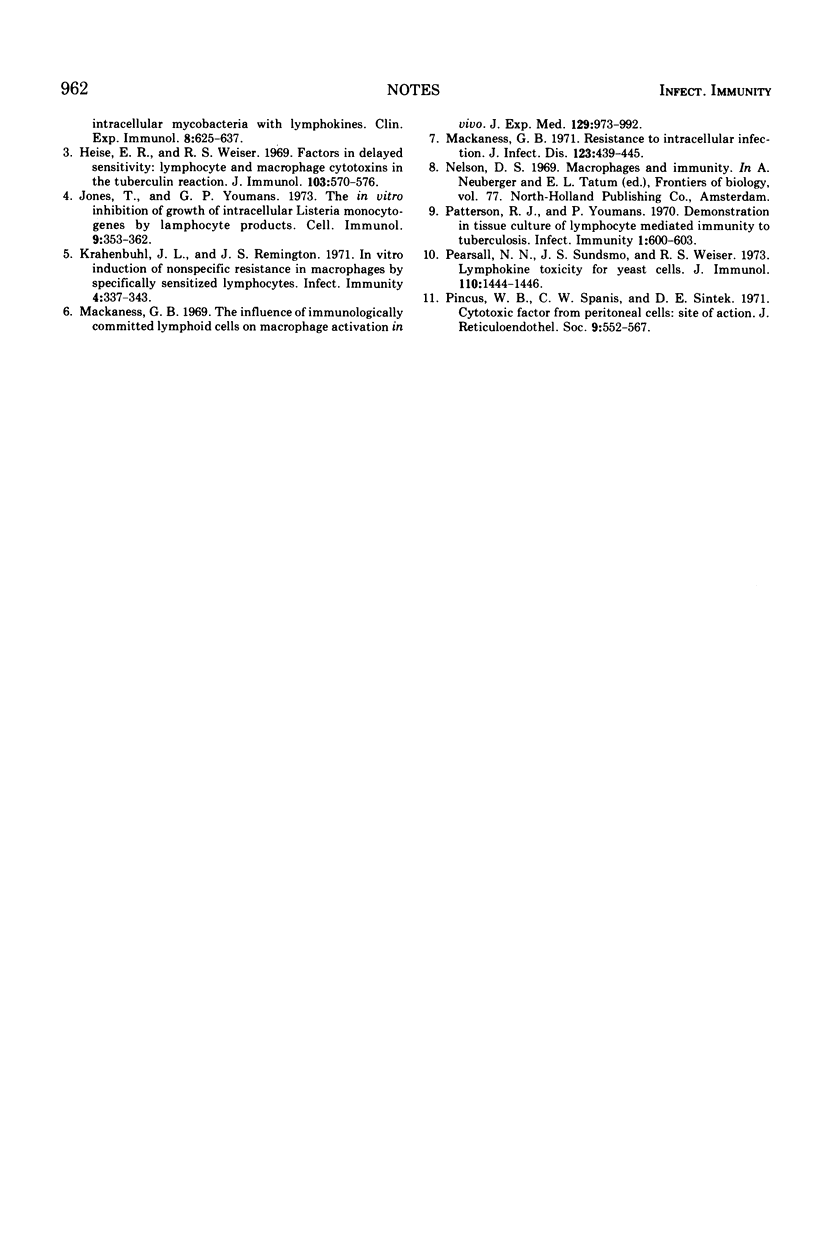Abstract
The importance of macrophages as effector cells in cellular reactions of immunity and hypersensitivity is well established (8). Macrophages activated as a result of specific immunological events exhibit increased microbicidal activity not only for the primary organism used for immunization purposes but also against unrelated intracellular pathogens (7). It is believed that the acquisition of this bactericidal or bacteriostatic activity is conferred on macrophages by materials released during the interaction of specifically immune lymphocytes with the antigen (Fowles et al., 1973; Godal et al., 1971; Jones and Youmans, 1973; Krahenbuhl and Remington, 1971; Mackaness, 1971; Patterson and Youmans, 1970). The antimicrobial activity in these studies refers to the intracellular inhibition and/or killing of the organisms; no attempts were made to assess the effect of activated macrophages on the extracellularly residing organisms. In an earlier study with the pathogenic yeastlike fungus Cryptococcus neoformans, we observed that freshly collected peritoneal macrophages from mice pretreated with a variety of nonspecific agents or from specifically immune mice possessed the capacity to exert anti-cryptococcal effect both on intracellular yeasts as well as those present in the extracellular milieu (Sethi et al., 1971; Sethi and Pelster, in press). Our results suggest that soluble product(s) released from mouse macrophages immune to Listeria monocytogenes can exert antilisterial activity under in vitro conditions.
Full text
PDF


Selected References
These references are in PubMed. This may not be the complete list of references from this article.
- Bast R. C., Jr, Cleveland R. P., Littman B. H., Zbar B., Rapp H. J. Acquired cellular immunity: extracellular killing of Listeria monocytogenes by a product of immunologically activated macrophages. Cell Immunol. 1974 Feb;10(2):248–259. doi: 10.1016/0008-8749(74)90116-6. [DOI] [PubMed] [Google Scholar]
- Fowles R. E., Fajardo I. M., Leibowitch J. L., David J. R. The enhancement of macrophage bacteriostasis by products of activated lymphocytes. J Exp Med. 1973 Oct 1;138(4):952–964. doi: 10.1084/jem.138.4.952. [DOI] [PMC free article] [PubMed] [Google Scholar]
- Godal T., Rees R. J., Lamvik J. O. Lymphocyte-mediated modification of blood-derived macrophage function in vitro; inhibition of growth of intracellular mycobacteria with lymphokines. Clin Exp Immunol. 1971 Apr;8(4):625–637. [PMC free article] [PubMed] [Google Scholar]
- Heise E. R., Weiser R. S. Factors in delayed sensitivity: lymphocyte and macrophage cytotoxins in the tuberculin reaction. J Immunol. 1969 Sep;103(3):570–576. [PubMed] [Google Scholar]
- Jones T., Youmans G. P. The in vitro inhibition of growth of intracellular Listeria monocytogenes by lymphocyte products. Cell Immunol. 1973 Dec;9(3):353–362. doi: 10.1016/0008-8749(73)90050-6. [DOI] [PubMed] [Google Scholar]
- Krahenbuhl J. L., Remington J. S. In vitro induction of nonspecific resistance in macrophages by specifically sensitized lymphocytes. Infect Immun. 1971 Oct;4(4):337–343. doi: 10.1128/iai.4.4.337-343.1971. [DOI] [PMC free article] [PubMed] [Google Scholar]
- Mackaness G. B. Resistance to intracellular infection. J Infect Dis. 1971 Apr;123(4):439–445. doi: 10.1093/infdis/123.4.439. [DOI] [PubMed] [Google Scholar]
- Mackaness G. B. The influence of immunologically committed lymphoid cells on macrophage activity in vivo. J Exp Med. 1969 May 1;129(5):973–992. doi: 10.1084/jem.129.5.973. [DOI] [PMC free article] [PubMed] [Google Scholar]
- Patterson R. J., Youmans G. P. Demonstration in tissue culture of lymphocyte-mediated immunity to tuberculosis. Infect Immun. 1970 Jun;1(6):600–603. doi: 10.1128/iai.1.6.600-603.1970. [DOI] [PMC free article] [PubMed] [Google Scholar]
- Pearsall N. N., Sundsmo J. S., Weiser R. S. Lymphokine toxicity for yeast cells. J Immunol. 1973 May;110(5):1444–1446. [PubMed] [Google Scholar]
- Pincus W. B., Spanis C. W., Sintek D. E. Cytotoxic factor from peritoneal cells: site of action. J Reticuloendothel Soc. 1971 Jun;9(6):552–567. [PubMed] [Google Scholar]


